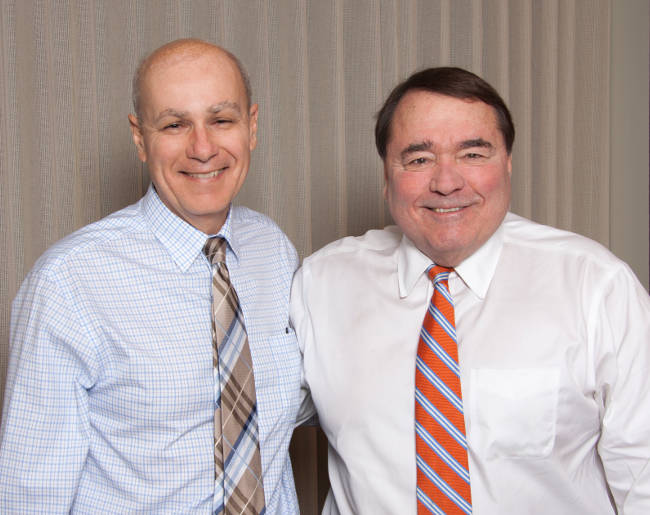Home > News & Events > A merger story: Tom Minogue and Jack Musgrave discuss 20 years as Thompson Coburn
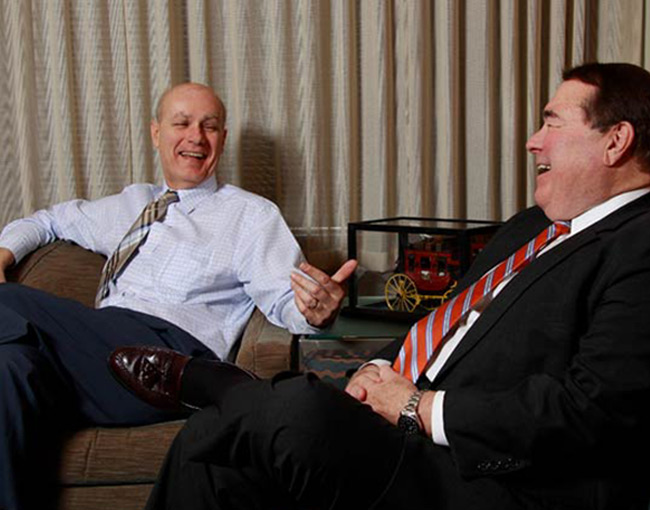
A merger story: Tom Minogue and Jack Musgrave discuss 20 years as Thompson Coburn
April 1, 2016
It was called “Project Tower.” A confidential merger of two highly respected St. Louis law firms that was finalized on April 1, 1996. Coburn & Croft and Thompson & Mitchell were already situated on adjacent floors of the then-Mercantile Tower building (which gave the merger its code name). But, in the eyes of some, the two firms were quite far apart in terms of culture.
“There was some speculation back then in the legal community that we wouldn’t be a fit for each other. Wow, was that ever wrong!” said Chairman Tom Minogue, the then-chairman of Thompson & Mitchell, whose history in St. Louis stretched back for decades. As pointed out by Jack Musgrave, who led Coburn & Croft and served as Thompson Coburn’s first sole chairman after he and Tom co-chaired the firm together for a year and a half, the combined firm’s intense focus on creating a culture of total commitment to clients — and each other — made it easy for longtime members of each organization to quickly see themselves as Thompson Coburn.
Today, on the 20th anniversary of the Thompson Coburn merger, enjoy this candid conversation between the combined firm’s founding leaders on how the two firms came together, avoided the ampersand, and spurred “transformative change” for lawyers, clients, and each other.
Why merge?
Tom: At the time, there was a group of law firms in St. Louis who mirrored each other pretty closely in terms of size and market share. We wanted to position ourselves as the marketplace leader.
Jack: Coburn & Croft had built a practice that was principally litigation, with very little corporate or transactional work. We recognized that to really become a full-service firm and improve our situation, we needed to add these types of practices. It was a bit of a daunting prospect to grow those areas organically, so we started thinking about firms that might be a good match for that need.
Tom: You had what was viewed by some as a corporate firm merging with a high-end litigation boutique. How could that work? Ultimately, it worked because both cultures changed.
Jack: That was bound to happen. It wouldn’t have been as successful as it became had people clung to their old cultures. It helped that so many partners in Coburn & Croft knew so many partners in Thompson & Mitchell. The firms were the first two tenants of the Mercantile Tower in 1976. [Coburn & Croft occupied the 27th, 28th, and 29th floors of the Mercantile Tower, now US Bank Plaza; Thompson & Mitchell occupied floors 30-34.] There was a certain level of comfort going into the merger and a belief that our own combined culture could be forged.
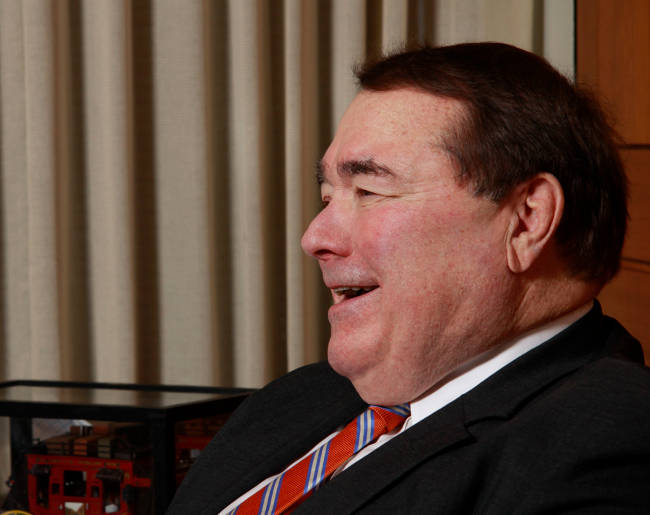
The merger begins
Jack: We had numerous committees, but when it got down to deciding what was important in leading our respective firms, most of the time spent on that was by Tom and me.
Tom: For the six months before the merger, and then the six months after, Jack and I met every week for at least half a day in a little conference room to knock down whatever had come up in the preceding week.
Without question one of the most important things we did was mix everyone’s offices up, so the former firms didn’t stay on their respective floors. Jack had been on 27 and I had been on 34, so we moved our offices right next to each other on the 30th, the floor right in the middle of everyone.
We had tried to get the merger done by January 1, but that didn’t happen. Way too much to do in too little time. So we somehow picked April 1 as the start date. April Fool’s Day! We thought, “Oh, what have we done? We can hear the jokes already.”
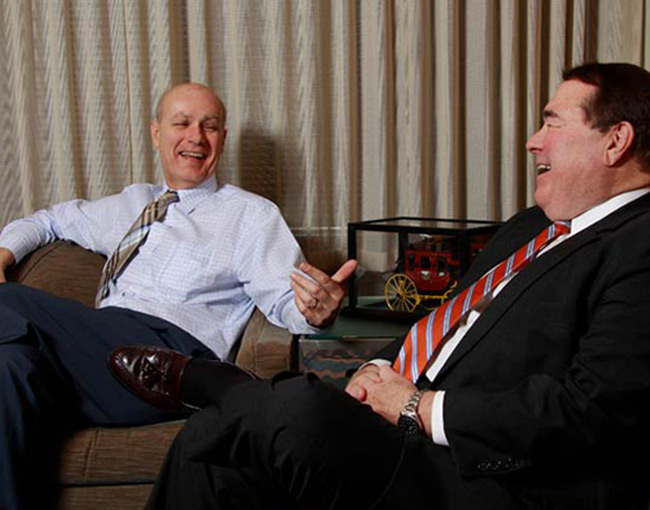
[The merger was announced in a press release sent to St. Louis media and embargoed for April 1, 1996.]
Jack: We had considered “Thompson & Coburn,” but at the time, everyone was going to a brand-type name. There was no Thompson or Coburn practicing, so the “&” was not necessary.
Tom: Yes, we didn’t want to do an ampersand because we wanted to be one firm, not “A & B.”
Jack: On the first day of the merger, we closed the office at 3 p.m. and had a big celebration at America’s Center.
The aftermath of the merger
Tom: The biggest change was that it immediately changed the vision of the firm, both in the external marketplace in our headquarters city and internally in the minds of our people.
Jack: From a more personal perspective — and I think you’d get the same answer from a lot of the more senior partners — what the merger really brought was the ability to provide a full range of services to our clients. Now when they called, instead of saying, “Gee, I don’t know anything about that,” or “Our firm doesn’t do that,” we had the ability to immediately get answers to client questions because of the breadth and depth of our experience.
And it was a real pleasure and very gratifying to put teams together to work for the good of the client, and see the end product, where you know you’ve done a good job and represented the fine caliber of the firm. When that piece came together, that was transformative for me as a lawyer.
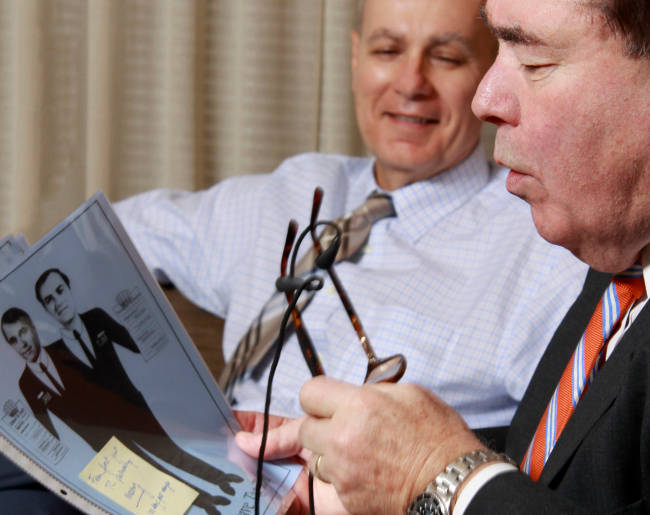
Tom and Jack as leaders
For 18 months after the merger, Tom and Jack served as co-chairs of the combined firm, appearing together so frequently that the then-COO joked in a firmwide memo that at the next firm picnic, a raffle prize would be handed out to the first person “to guess the precise day and hour when Musgrave and Minogue will merge into a single person.” A humorous “merged Musgrave/Minogue” image was also created and displayed at a partner meeting following the merger.
Jack: Part of that was the way we worked together over that first year and a half. Both of us were going out of our way to keep the other informed. [Jack served as the chairman of Thompson Coburn for the next five years before stepping down in July 2002 and handing the reins back to Tom.]
Tom: Over that year and half working on our merger, I learned from Jack that there’s no problem, nothing, that you can’t dive into, figure out, and solve.
Jack: I learned from Tom the importance of really paying attention to the details before you make a decision. This merger experience was a real eye-opener, and I watched Tom very adroitly get himself involved in all kinds of areas, so he could help everyone understand what was happening and make it work.
Creating our culture
Jack: Tom and I both realized that getting the merger down on paper was the easy part. The hard part was all the work that had to be done afterwards to make it work. There’s that notion that “the only constant is change,” and we had to embrace that.
Tom: Within a few short weeks after the merger, we decided we had to figure out the values of the new firm. We had at least a dozen meetings — every Saturday morning for three or four months — where our management had broad-ranging conversations about who we were and what we wanted to be.
Jack: The smartest thing we did was really focus on our culture. Before we merged, I thought, “culture — that’s just a buzzword people use.” But I came to realize the impact and importance of culture and that forging one was vitally important to the continued success and growth of the new firm. It is harder and harder today to instill that.
Tom: Both of the firms were all in. There was no looking back, only looking forward. We had jumped off a cliff together and were determined to make it work.
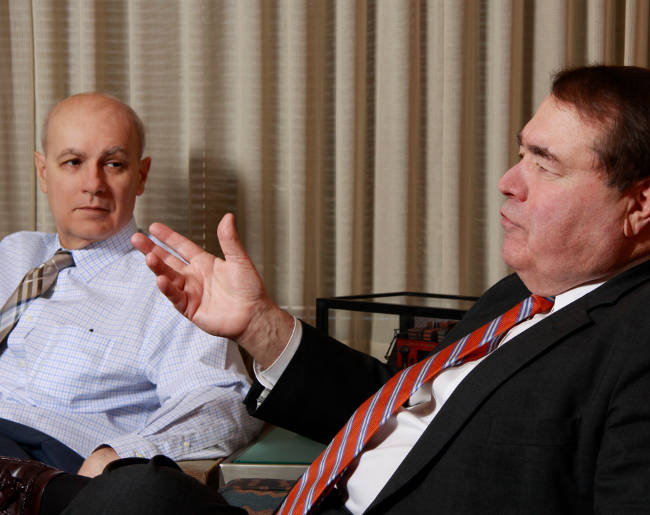
Reflecting back, looking forward
Tom: Twenty years later, it’s still the largest law firm merger of two St. Louis-based law firms. And it laid the groundwork for all the changes that came after: scores of lateral partners, the Howell & Haferkamp intellectual property merger, Chicago, Los Angeles, our growth in Washington, D.C. It was the seminal event in the history of the firm.
Jack: There’s no question about that. We brought a lot to each other that has worked out well over the years.
Every year goes by faster and faster. The merger doesn’t seem that long ago. When you stop and think about, about all that has happened and what we’ve done, I come to the realization that I think of myself more as a Thompson Coburn partner than I ever did as a Coburn & Croft partner. Other than the Kemner case [the more than three-year trial for Monsanto in St. Clair County, Ill., that was the longest trial in U.S. history] and living through that, most of my fond memories are of the merged firm.
Tom: You have to figure that at least 80 percent of the lawyers in our firm today have never known anything other than Thompson Coburn; there is no other reality. And, really, within two or three years of the merger, everyone thought of themselves as TC.
Jack: Twenty years from now? It’s hard to project out that far. And there are some challenges out there today, but we’ve got a good thing going.
Tom: Twenty years from today I hope two new and different people are sitting in a room like this celebrating the accomplishments of TC over the preceding 20 years!
